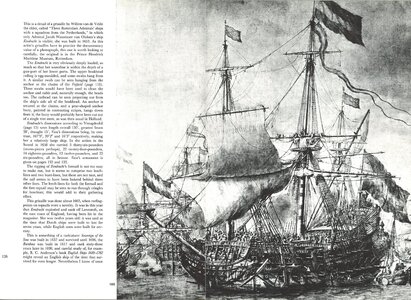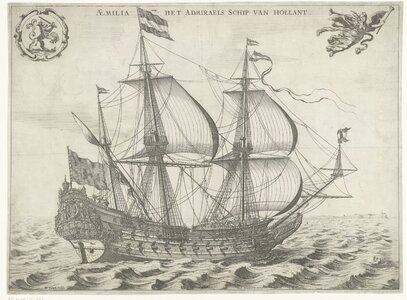-

Win a Free Custom Engraved Brass Coin!!!
As a way to introduce our brass coins to the community, we will raffle off a free coin during the month of August. Follow link ABOVE for instructions for entering.
You are using an out of date browser. It may not display this or other websites correctly.
You should upgrade or use an alternative browser.
You should upgrade or use an alternative browser.
Vasa - 1:65 DeAgostini [COMPLETED BUILD]
- Thread starter dockattner
- Start date
- Watchers 147
On the drwng it looks quite a big size vessel  )) , can imagine how biggest will looks like!
)) , can imagine how biggest will looks like!
1st rate... must be "gigantish" !!! )) and all from wood!
)) and all from wood!
1st rate... must be "gigantish" !!!
What I find interesting is the length of the robands that hold the sails to the yards. The tell-tail ends of the robands hang down onto the sails as long as the reefing points. Something to take note of in my build.On Vroom's pictures, topsails leechlines ommited as a rule, and only one central buntlines shown... later on, when martnets on the course sails disappeared at all, there are two leechlines only shown on the top sails and course as well ... as we could see on the Van de Velde drwngs...this is a difference , but in the same time, martnets for top sails halliards still in use...
View attachment 309954
View attachment 309955
View attachment 309956
View attachment 309957
- Joined
- Aug 8, 2019
- Messages
- 5,467
- Points
- 738

Sorry to ask, what do you mean with martnets for top sail halliards?but in the same time, martnets for top sails halliards still in use...
The term Martnets is normally used for a leechline on a square rigged ship when it is arranged whit crowfeet. And only the course got them like your drawings show.
Or do you mean the crowfeet on the halyard of the topsail and topgallant yard?
- Joined
- Aug 8, 2019
- Messages
- 5,467
- Points
- 738

When you zoom in you can see that these line hang in between the robands. When it where the long ends of the robands then they would hang on the back of the sail because the knot of the roband is on the back of the yard.What I find interesting is the length of the robands that hold the sails to the yards. The tell-tail ends of the robands hang down onto the sails as long as the reefing points. Something to take note of in my build.
Good day Stephan,Sorry to ask, what do you mean with martnets for top sail halliards?
The term Martnets is normally used for a leechline on a square rigged ship when it is arranged whit crowfeet. And only the course got them like your drawings show.
Or do you mean the crowfeet on the halyard of the topsail and topgallant yard?
Yes,sorry, You are right!
sure I meant crowfeet of the topsails halyards ... looks like there was some transition period when martnets of the sails rigging became out of use and were replaced by modern looks leechlines and buntlines, but halyards with rigged crowfeets were still in use...
Anybody knows , original Vasa blocks ... are they recovered , existed?
Where we could see them?
Have some Doubts that euphroe made by Paul have correct geometrical shape... but not sure...
Where we could see them?
Have some Doubts that euphroe made by Paul have correct geometrical shape... but not sure...
May be here? Cant load, no internet speed...
 thescholarship.ecu.edu
thescholarship.ecu.edu
The Rigging and Gun Tackle Blocks of the Swedish Royal Warship Vasa
Hello Kirill,Anybody knows , original Vasa blocks ... are they recovered , existed?
Where we could see them?
Have some Doubts that euphroe made by Paul have correct geometrical shape... but not sure...
I have a copy of a master's thesis that will answer your question but the file is too large to post on the forum. If you message me your email address I can send it to you. Same offer for anyone interested.
Here is an image from the museum showing a large euphroe. I found that tapering in the manner shown simply lead to part failure so I left both ends rounded. I suspect that pearwood inherently lacks the strength needed.
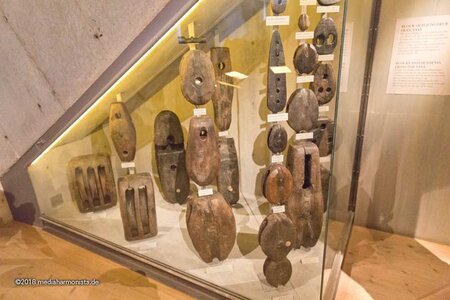
Good day Paul,
Thank You very much, in a week we will be in the port, I hope shore internet will be much faster, and I will downliad it ...
Thanks for the offer, and foto of Vasa blocks!!!...
I understood why You made euphroe in such shape...
couldn't You try to "soak " this piece of wooden stick for euphroe in super liquid CA, and when it dry,try to work with it... maybe it could reinforce wood , and make it less fragile?
All the best!!!
Thank You very much, in a week we will be in the port, I hope shore internet will be much faster, and I will downliad it ...
Thanks for the offer, and foto of Vasa blocks!!!...
I understood why You made euphroe in such shape...
couldn't You try to "soak " this piece of wooden stick for euphroe in super liquid CA, and when it dry,try to work with it... maybe it could reinforce wood , and make it less fragile?
All the best!!!
- Joined
- Jan 9, 2020
- Messages
- 10,534
- Points
- 938

Hello Friends,
In order to get a head-start on the American holiday this coming Monday, I took today (Friday) off as well. With nothing planned I managed to spend most of the day working on my ship. It's been a while since I have been able to do that, so it was a special treat. Today's mission was halyards.
First up let's look at the halyard for the mizzen mast. Unlike the other halyards, which all run aft of their respective masts, the mizzen halyard runs forward. Here is the working end (yards are not yet installed so the line is just running through a sheave near the top of the mizzen mast and taped down for now):
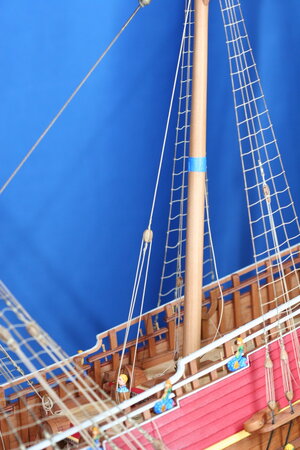
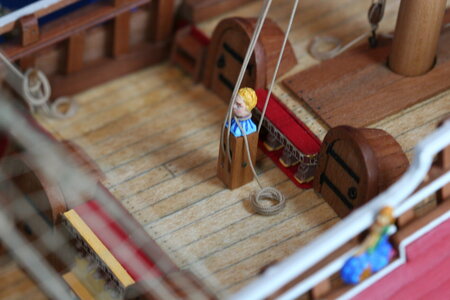
On the fore topmast and the fore topgallant, the halyards run to the stays and end in crows-feet. This was extraordinarily challenging to accomplish because any tension on the halyard pulls the stay out of alignment - but the crows-feet need some tension, or they look sloppy. I made a builder's decision that keeping the stays relatively straight was visually more important than perfect crows-feet. I may change my mind later as the build progresses.
In the images below you can see how the working end passes through a directional block attached to the stay below the crows-feet and is then run to the base of the mast. Nearly everyone just ties the line off to an eyebolt. While I do not doubt this is correct, I can't see how that arrangement would allow for hoisting the yard. My solution was to add a block to the eyebolt so the halyard could be hauled on by a group of men on the deck, or even run to the capstan. I'm 90% sure I did this wrong...
Anyway, here is the foremast overall picture:
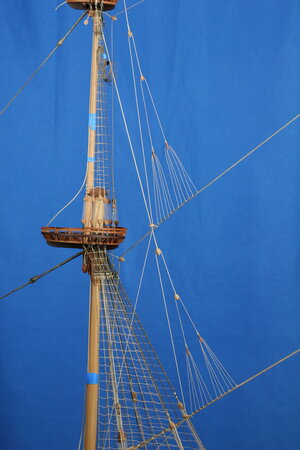
A closer look at the topgallant tie (tye) and halyard:
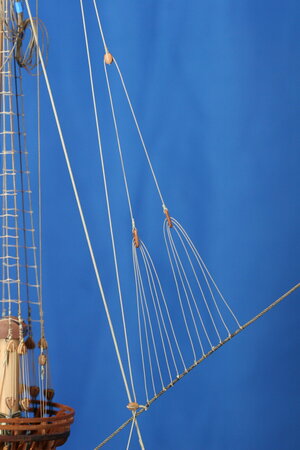
And now a look at the fore topmast halyard:
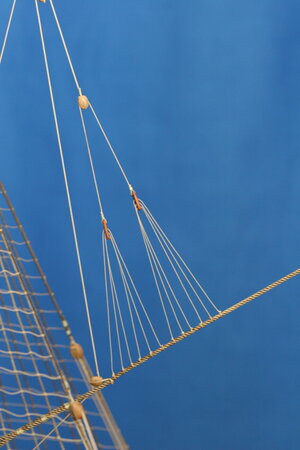
Here is how I have 'belayed' these halyards at the base of the foremast (one on each side):
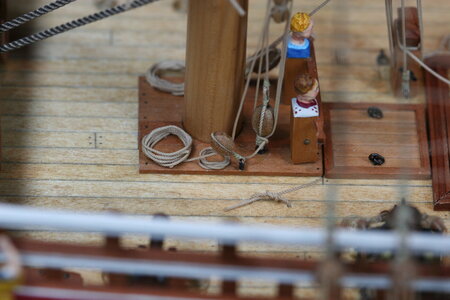
Next, the overall view showing the main topmast and main topgallant halyards:
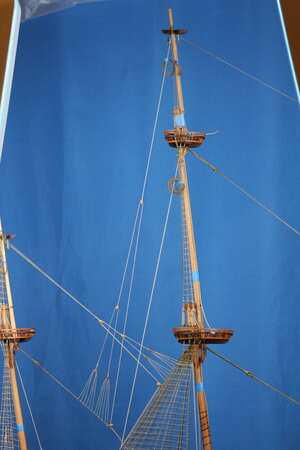
The main topmast halyard does not run to a stay, rather, it runs to a knighthead:
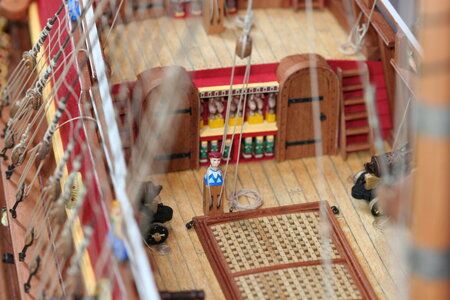
And finally, a closer look at the painfully difficult main topgallant crows-feet:
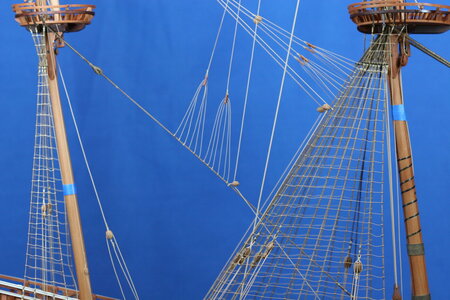
In the US (on Monday) we remember the men and women who died while serving in our military. I am grateful to them, as well as to all who have served. I hope you all have such a day in your home countries as well. It is a good thing to remember and give thanks, even as we long for a time when war will no longer be a part of our planet's story.
Thanks for visiting!
Just a few more random images someone might find helpful. Fore topgallant:
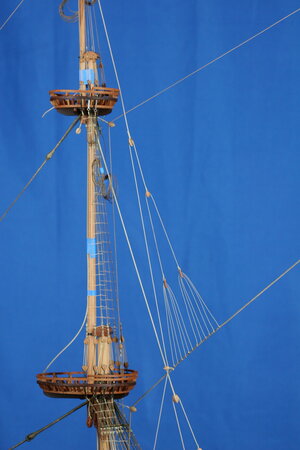
Fore topmast and part of the topgallant:
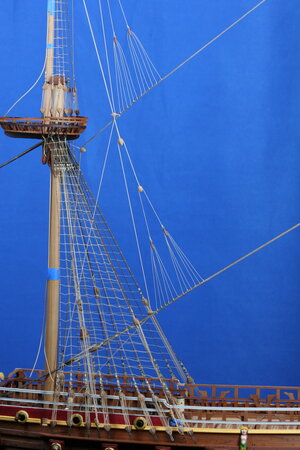
Fore topmast but closer in:
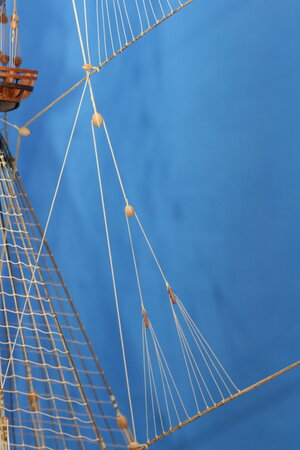
Fore topgallant again but closer...
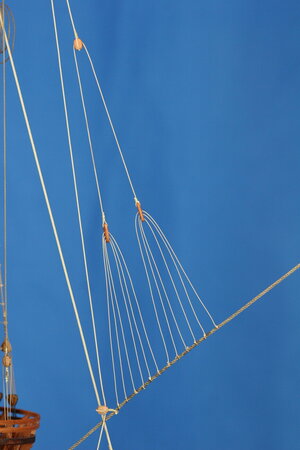
In order to get a head-start on the American holiday this coming Monday, I took today (Friday) off as well. With nothing planned I managed to spend most of the day working on my ship. It's been a while since I have been able to do that, so it was a special treat. Today's mission was halyards.
First up let's look at the halyard for the mizzen mast. Unlike the other halyards, which all run aft of their respective masts, the mizzen halyard runs forward. Here is the working end (yards are not yet installed so the line is just running through a sheave near the top of the mizzen mast and taped down for now):


On the fore topmast and the fore topgallant, the halyards run to the stays and end in crows-feet. This was extraordinarily challenging to accomplish because any tension on the halyard pulls the stay out of alignment - but the crows-feet need some tension, or they look sloppy. I made a builder's decision that keeping the stays relatively straight was visually more important than perfect crows-feet. I may change my mind later as the build progresses.
In the images below you can see how the working end passes through a directional block attached to the stay below the crows-feet and is then run to the base of the mast. Nearly everyone just ties the line off to an eyebolt. While I do not doubt this is correct, I can't see how that arrangement would allow for hoisting the yard. My solution was to add a block to the eyebolt so the halyard could be hauled on by a group of men on the deck, or even run to the capstan. I'm 90% sure I did this wrong...
Anyway, here is the foremast overall picture:

A closer look at the topgallant tie (tye) and halyard:

And now a look at the fore topmast halyard:

Here is how I have 'belayed' these halyards at the base of the foremast (one on each side):

Next, the overall view showing the main topmast and main topgallant halyards:

The main topmast halyard does not run to a stay, rather, it runs to a knighthead:

And finally, a closer look at the painfully difficult main topgallant crows-feet:

In the US (on Monday) we remember the men and women who died while serving in our military. I am grateful to them, as well as to all who have served. I hope you all have such a day in your home countries as well. It is a good thing to remember and give thanks, even as we long for a time when war will no longer be a part of our planet's story.
Thanks for visiting!
Just a few more random images someone might find helpful. Fore topgallant:

Fore topmast and part of the topgallant:

Fore topmast but closer in:

Fore topgallant again but closer...

Last edited:
Hello Paul,
Looks nice !!! Well done!!!
Looks nice !!! Well done!!!
Paul,
Beautiful rigging as usual. With regard to your euphroe blocks, below is a picture from the Vasa digital archive. It is similar to the pictures of blocks you showed and those shown in the blocks thesis by Howe (2011). I had the same problem as you when fabricating these euphroe blocks and trying to get the correct tapered shape. I found when I ran the crowsfeet lines and applied any tension, the wood would split. To overcome this, I rotated the wood stock 90 degrees and made the blocks with the grain running across the block. I was using the fine grained Huon Pine, and it worked a treat. What timber are you using? I love that dark red colour.
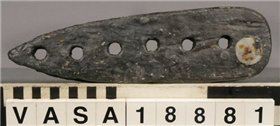
Another problem I faced to, and I note you are too, is the tight line turn that you are attempting on the ropes going through the euphroe blocks. They have a tendancy to curve (albeit tightly), but not the sharp angles of the ropes as I am sure they would have been.
Regards,
PeterG.
Beautiful rigging as usual. With regard to your euphroe blocks, below is a picture from the Vasa digital archive. It is similar to the pictures of blocks you showed and those shown in the blocks thesis by Howe (2011). I had the same problem as you when fabricating these euphroe blocks and trying to get the correct tapered shape. I found when I ran the crowsfeet lines and applied any tension, the wood would split. To overcome this, I rotated the wood stock 90 degrees and made the blocks with the grain running across the block. I was using the fine grained Huon Pine, and it worked a treat. What timber are you using? I love that dark red colour.

Another problem I faced to, and I note you are too, is the tight line turn that you are attempting on the ropes going through the euphroe blocks. They have a tendancy to curve (albeit tightly), but not the sharp angles of the ropes as I am sure they would have been.
Regards,
PeterG.
Good morning Paul. Beautiful work as always. Those crows feet lines seem impossible to tension tight without pulling the stay up and thus not linear. I would be interested if any modeler has managed both. The chap on the knight head looks like he has been sent to the gallows-Hello Friends,
In order to get a head-start on the American holiday this coming Monday, I took today (Friday) off as well. With nothing planned I managed to spend most of the day working on my ship. It's been a while since I have been able to do that, so it was a special treat. Today's mission was halyards.
First up let's look at the halyard for the mizzen mast. Unlike the other halyards, which all run aft of their respective masts, the mizzen halyard runs forward. Here is the working end (yards are not yet installed so the line is just running through a sheave near the top of the mizzen mast and taped down for now):
View attachment 310728
View attachment 310729
On the fore topmast and the fore topgallant, the halyards run to the stays and end in crows-feet. This was extraordinarily challenging to accomplish because any tension on the halyard pulls the stay out of alignment - but the crows-feet need some tension, or they look sloppy. I made a builder's decision that keeping the stays relatively straight was visually more important than perfect crows-feet. I may change my mind later as the build progresses.
In the images below you can see how the working end passes through a directional block attached to the stay below the crows-feet and is then run to the base of the mast. Nearly everyone just ties the line off to an eyebolt. While I do not doubt this is correct, I can't see how that arrangement would allow for hoisting the yard. My solution was to add a block to the eyebolt so the halyard could be hauled on by a group of men on the deck, or even run to the capstan. I'm 90% sure I did this wrong...
Anyway, here is the foremast overall picture:
View attachment 310726
A closer look at the topgallant tie (tye) and halyard:
View attachment 310730
And now a look at the fore topmast halyard:
View attachment 310733
Here is how I have 'belayed' these halyards at the base of the foremast (one on each side):
View attachment 310727
Next, the overall view showing the main topmast and main topgallant halyards:
View attachment 310734
The main topmast halyard does not run to a stay, rather, it runs to a knighthead:
View attachment 310736
And finally, a closer look at the painfully difficult main topgallant crows-feet:
View attachment 310735
In the US (on Monday) we remember the men and women who died while serving in our military. I am grateful to them, as well as to all who have served. I hope you all have such a day in your home countries as well. It is a good thing to remember and give thanks, even as we long for a time when war will no longer be a part of our planet's story.
Thanks for visiting!
Just a few more random images someone might find helpful. Fore topgallant:
View attachment 310724
Fore topmast and part of the topgallant:
View attachment 310725
Fore topmast but closer in:
View attachment 310731
Fore topgallant again but closer...
View attachment 310732
Lovely work Paul,Hello Friends,
In order to get a head-start on the American holiday this coming Monday, I took today (Friday) off as well. With nothing planned I managed to spend most of the day working on my ship. It's been a while since I have been able to do that, so it was a special treat. Today's mission was halyards.
First up let's look at the halyard for the mizzen mast. Unlike the other halyards, which all run aft of their respective masts, the mizzen halyard runs forward. Here is the working end (yards are not yet installed so the line is just running through a sheave near the top of the mizzen mast and taped down for now):
View attachment 310728
View attachment 310729
On the fore topmast and the fore topgallant, the halyards run to the stays and end in crows-feet. This was extraordinarily challenging to accomplish because any tension on the halyard pulls the stay out of alignment - but the crows-feet need some tension, or they look sloppy. I made a builder's decision that keeping the stays relatively straight was visually more important than perfect crows-feet. I may change my mind later as the build progresses.
In the images below you can see how the working end passes through a directional block attached to the stay below the crows-feet and is then run to the base of the mast. Nearly everyone just ties the line off to an eyebolt. While I do not doubt this is correct, I can't see how that arrangement would allow for hoisting the yard. My solution was to add a block to the eyebolt so the halyard could be hauled on by a group of men on the deck, or even run to the capstan. I'm 90% sure I did this wrong...
Anyway, here is the foremast overall picture:
View attachment 310726
A closer look at the topgallant tie (tye) and halyard:
View attachment 310730
And now a look at the fore topmast halyard:
View attachment 310733
Here is how I have 'belayed' these halyards at the base of the foremast (one on each side):
View attachment 310727
Next, the overall view showing the main topmast and main topgallant halyards:
View attachment 310734
The main topmast halyard does not run to a stay, rather, it runs to a knighthead:
View attachment 310736
And finally, a closer look at the painfully difficult main topgallant crows-feet:
View attachment 310735
In the US (on Monday) we remember the men and women who died while serving in our military. I am grateful to them, as well as to all who have served. I hope you all have such a day in your home countries as well. It is a good thing to remember and give thanks, even as we long for a time when war will no longer be a part of our planet's story.
Thanks for visiting!
Just a few more random images someone might find helpful. Fore topgallant:
View attachment 310724
Fore topmast and part of the topgallant:
View attachment 310725
Fore topmast but closer in:
View attachment 310731
Fore topgallant again but closer...
View attachment 310732
Maybe this is an idea for you and PeterG.
The crows-feet look like a hassle, I wonder if thinned PVA/white glue brushed onto the crows-feet whilst in tension would stiffen it up enough, maybe temporarily putting more tension on the stay to reduce the "kink" and once set reduce the tension in the crows-feet so the stay doesn't have a "kink" in it.
I would suggest doing some experimentation off the model with some sort of simulation.
Cheers,
Stephen.
Exquisite work Paul. What a fine instructional photo essay which I will bookmark and use as a guide.Hello Friends,
In order to get a head-start on the American holiday this coming Monday, I took today (Friday) off as well. With nothing planned I managed to spend most of the day working on my ship. It's been a while since I have been able to do that, so it was a special treat. Today's mission was halyards.
First up let's look at the halyard for the mizzen mast. Unlike the other halyards, which all run aft of their respective masts, the mizzen halyard runs forward. Here is the working end (yards are not yet installed so the line is just running through a sheave near the top of the mizzen mast and taped down for now):
View attachment 310728
View attachment 310729
On the fore topmast and the fore topgallant, the halyards run to the stays and end in crows-feet. This was extraordinarily challenging to accomplish because any tension on the halyard pulls the stay out of alignment - but the crows-feet need some tension, or they look sloppy. I made a builder's decision that keeping the stays relatively straight was visually more important than perfect crows-feet. I may change my mind later as the build progresses.
In the images below you can see how the working end passes through a directional block attached to the stay below the crows-feet and is then run to the base of the mast. Nearly everyone just ties the line off to an eyebolt. While I do not doubt this is correct, I can't see how that arrangement would allow for hoisting the yard. My solution was to add a block to the eyebolt so the halyard could be hauled on by a group of men on the deck, or even run to the capstan. I'm 90% sure I did this wrong...
Anyway, here is the foremast overall picture:
View attachment 310726
A closer look at the topgallant tie (tye) and halyard:
View attachment 310730
And now a look at the fore topmast halyard:
View attachment 310733
Here is how I have 'belayed' these halyards at the base of the foremast (one on each side):
View attachment 310727
Next, the overall view showing the main topmast and main topgallant halyards:
View attachment 310734
The main topmast halyard does not run to a stay, rather, it runs to a knighthead:
View attachment 310736
And finally, a closer look at the painfully difficult main topgallant crows-feet:
View attachment 310735
In the US (on Monday) we remember the men and women who died while serving in our military. I am grateful to them, as well as to all who have served. I hope you all have such a day in your home countries as well. It is a good thing to remember and give thanks, even as we long for a time when war will no longer be a part of our planet's story.
Thanks for visiting!
Just a few more random images someone might find helpful. Fore topgallant:
View attachment 310724
Fore topmast and part of the topgallant:
View attachment 310725
Fore topmast but closer in:
View attachment 310731
Fore topgallant again but closer...
View attachment 310732
Excellent idea Stephen!Lovely work Paul,
Maybe this is an idea for you and PeterG.
The crows-feet look like a hassle, I wonder if thinned PVA/white glue brushed onto the crows-feet whilst in tension would stiffen it up enough, maybe temporarily putting more tension on the stay to reduce the "kink" and once set reduce the tension in the crows-feet so the stay doesn't have a "kink" in it.
I would suggest doing some experimentation off the model with some sort of simulation.
Cheers,
Stephen.


